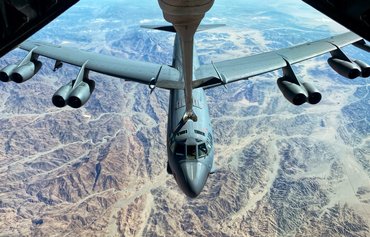The US military employs a number of aircraft that are able to insert special forces inside conflict zones around the world, rapidly and with little detection, and to extract them safely when operations have concluded.
Two aircraft in particular are key to this effort: the US Air Force's HH-60 Pave Hawk helicopter and HC-130 Combat King fixed wing aircraft.
Both of these aircraft can conduct combat search and rescue (CSAR) missions in hostile environments as well as the insertion and extraction of special forces.
The Pave Hawk is a highly modified version of the Army Black Hawk helicopter that features upgraded communications and navigation.
![Airmen and equipment arrive aboard an HC-130J Combat King II aircraft. [US Air Force]](/cnmi_am/images/2023/01/05/39852-180915-f-pb262-9001-600_384.jpg)
Airmen and equipment arrive aboard an HC-130J Combat King II aircraft. [US Air Force]
![A US pilot performs a visual confirmation with night vision goggles during a training mission. Similar technology is used in the HC-130 Combat Kings. [US Air Force]](/cnmi_am/images/2023/01/05/39900-151014-d-hq914-757-600_384.jpg)
A US pilot performs a visual confirmation with night vision goggles during a training mission. Similar technology is used in the HC-130 Combat Kings. [US Air Force]
![An aircrew member performs an airdrop out of an HC-130 in 2021. [US Air Force]](/cnmi_am/images/2023/01/05/39901-airdrop-600_384.jpg)
An aircrew member performs an airdrop out of an HC-130 in 2021. [US Air Force]
All Pave Hawks have an automatic flight control system and night vision goggles with an infrared system that greatly enhances low-level night operations.
In addition to performing military operations, the Pave Hawk is tasked with civil search and rescue, medical evacuation, disaster response and humanitarian assistance.
Over the years, HH-60 crews have aided hundreds of American, coalition and foreign-national personnel by conducting personnel recovery and medical evacuations under low visibility, low illumination conditions at all altitudes.
During the 1991 Gulf War, Pave Hawk helicopters provided combat search and rescue coverage for coalition forces in western Iraq, coastal Kuwait, the Arabian Gulf and Saudi Arabia.
Today, they continue to deploy in support of operations in Afghanistan, Iraq and Libya.
Avoiding detection
Meanwhile, the HC-130 Combat King is a fixed-wing aircraft primarily designed to conduct recovery operations from austere airfields and denied territory.
The aircraft is an extended-range version of the C-130 Hercules transport.
HC-130 crews employ tactics that include incorporating no external lighting or communications and avoiding radar and weapon detection.
The HC-130 can fly in the day; however, crews normally fly at night at low to medium altitudes in contested or sensitive environments, both over land and over water.
HC-130s often perform tactical airdrops of special force teams, small bundles, zodiac watercraft, or four-wheel drive all-terrain vehicles.
Drop zone objectives are done via personnel and equipment drops. Rescue bundles include illumination flares, marker smokes and rescue kits.
With a fuel capacity of over 9,000 gallons, the aircraft has a maximum air speed of 316 knots at sea level, and can go up to 33,000 feet (10,000 meters).
The aircraft is also a key part of the US military's refuelling efforts.
HC-130s can perform helicopter air-to-air refuelling -- including at night, with blacked-out communication with up to two simultaneous helicopters.
Furthermore, the aircraft can execute forward area refuelling point operations to support a variety of joint and coalition partners.
This capability allows US Air Force aircraft to prepare for their next mission without having to return to an established base. This is part of Agile Combat Employment (ACE), which emphasises mobility even in hostile areas where infrastructure is scarce.
Beijing, which maintains the largest armed forces in the world by active duty military personnel, has nowhere near the refueling capability maintained by the US military, with some observers saying the United States has approximately 80% of the global military refueling aircraft.
"The US military's ability to promptly project power over intercontinental distances and sustain operations at theater scales is one of its most significant advantages," said a 2021 Hudson Institute report titled "Resilient Aerial Refueling: Safeguarding the US Military's Global Reach".
"Aerial refueling is arguably the most important contributor to this uniquely American capability," it said.

![An HH-60 Pave Hawk helicopter refuels off Japan. [US Air Force]](/cnmi_am/images/2023/01/05/39850-161107-f-pj289-9241-600_384.jpg)






